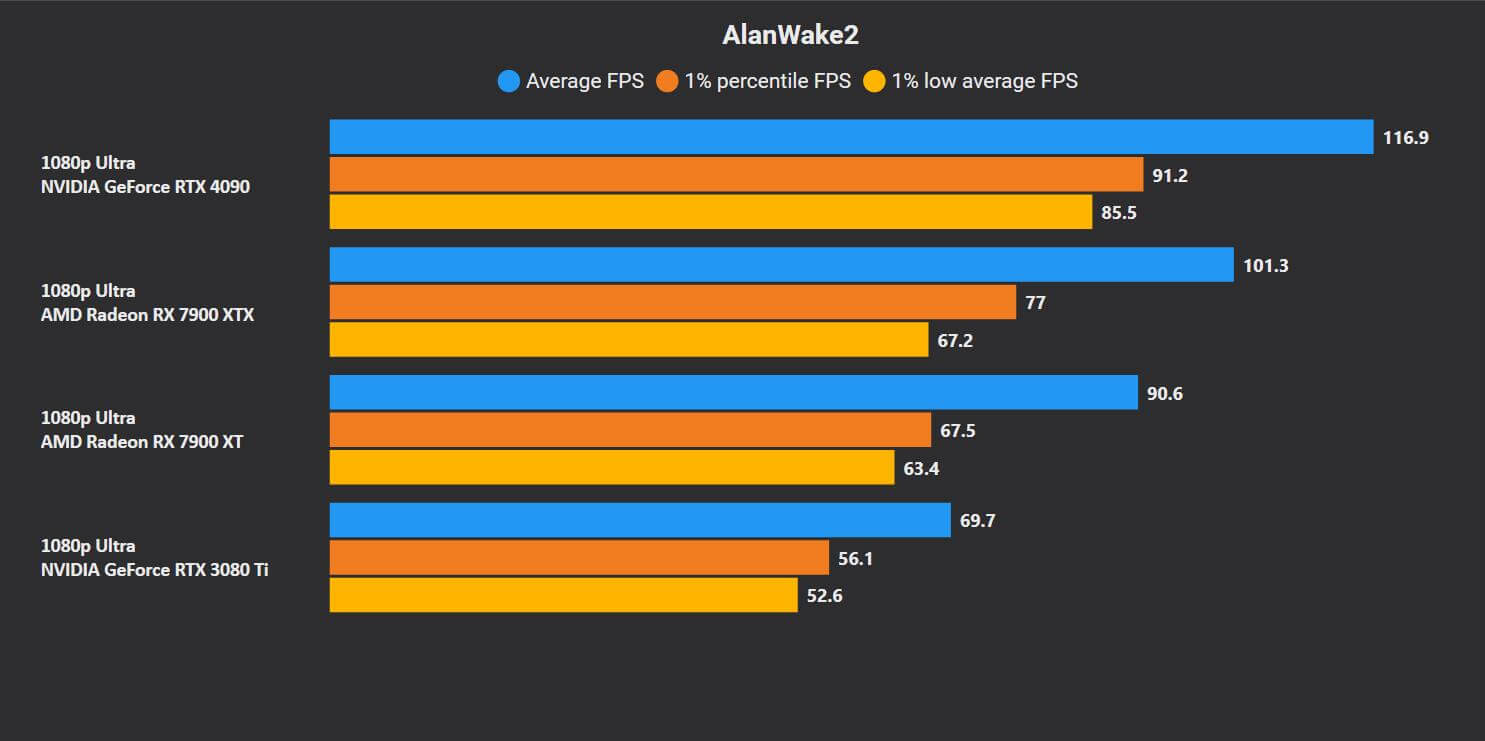Alan Wake 2 is finally out. Like Remedy’s past games, it pushes the boundaries of 3D rendering, mainly in the lighting department. We tested the game across multiple graphics cards, including the NVIDIA RTX 4090 and the AMD Radeon RX 7900 XTX. Alan Wake II is quite demanding, even without ray tracing, and you’ll need upscaling for a smooth, lag-free experience. Path tracing, enabled at Ray Tracing “High,” requires Frame Generation for acceptable frame rates. Unfortunately, only NVIDIA’s DLSS 3.5 solution is available at the moment.
Test Bench
- CPU: Intel Core i9-13900K.
- Cooler: Lian Li Galahad 360
- Motherboard: ASUS ROG Maximus Z790 Hero.
- Memory: 16GB x2 @6000MT/s CL38.
- PSU: Corsair RM1000E
Alan Wake 2 Benchmarks: NVIDIA RTX 4090 vs AMD RX 7900 XTX
At the default “Ultra” settings without ray tracing or path tracing, our two fastest GPUs managed an average of over 100 FPS. At 1080p, the GeForce RTX 4090 averaged 117 FPS, followed by the Radeon RX 7900 XTX with 101 FPS at the Ultra quality preset. The RX 7900 XT nets 90.6 FPS, while the GeForce RTX 3080 Ti ends last with a 70 FPS average.

At 1440p, the GeForce RTX 3080 Ti drops to 51 FPS, while the RX 7900 XT nets 65.5 FPS. The Radeon RX 7900 XTX and the RTX 4090 average a comfortable 73 FPS and 87 FPS, respectively.

At 4K, none of the GPUs hit 60 FPS, leaving the GeForce RTX 4090 with 51 FPS and the RX 7900 XTX with 42 FPS on average. The RX 7900 XT drops to 35.7 FPS, while the RTX 3080 Ti clings to 24.5 FPS. And this is without any ray or path tracing.


Alan Wake 2 Ray Tracing Low: No Path Tracing
At the Ray Tracing “Low” quality preset, Alan Wake II uses direct lighting and reflections. Indirect or diffuse lighting which uses path tracing is disabled. Screen space reflections and rasterized global illumination remain enabled. Players with NVIDIA RTX GPUs can enable Ray Reconstruction, which uses an AI-based denoiser to improve lighting quality and performance.
AMD FSR 3 “Fluid Motion Frames” Vs. NVIDIA DLSS 3: Image Quality Compared

At 1080p, the GeForce RTX 4090 is the only GPU that manages an average of over 60 FPS, while the rest drop to 40 FPS and lower. Unlike rasterization, the RTX 3080 Ti is faster than the Radeon RX 7900 XT and the 7900 XTX.

At 1440p, all but the RTX 4090 drop to less than 30 FPS, with lows nearing single-digit figures. The NVIDIA Ada flagship averages 63.6 FPS, while the RTX 3080 Ti manages 29.7 FPS. The Radeon RX 7900 XTX nets 27 FPS with lows of 12.7 FPS. Its XT sibling follows shortly. The RTX 4090 is twice as fast as the RX 7900 XTX with basic low-quality ray tracing. You can guess what happens with path tracing enabled.


At 4K, the GeForce RTX 4090 maintains an average of 30 FPS while the rest of the GPUs fall to early-to-mid teens, with single-digit lows.
Alan Wake 2 Path Tracing Benchmarks: NVIDIA RTX 4090 vs AMD RX 7900 XTX
Path tracing benchmarks on the next page…



